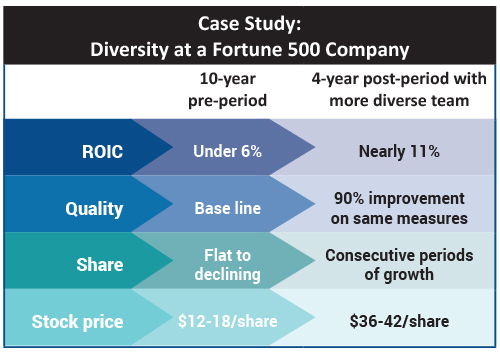3 minutes
Is it worth finding a variety of leaders for your organization?
In most organizations, the senior leadership is typically not diverse enough to include people of a variety of ethnicities—or even women. In fact, the Fortune 500 has fewer than 10 percent CEOs from minority groups, and the number of leaders who are not Caucasian or female at senior levels in most large organizations, across all industries, is also in the single digits.
As an executive recruiter who focuses on helping companies find diverse leaders, I interact with senior executives across industries, typically in larger firms. Some organizations have taken the perspective that their leadership is not diverse because there is not a need or there isn’t sufficient value in adding diversity to their senior leadership ranks.
This “old school” view is still pervasive. A way to address this line of thinking is with facts from objective sources.
An extensive study, “The Bottom Line: Corporate Performance and Women’s Representation on Boards,” was conducted of Fortune 500 companies between 2001 and 2004 by the non-profit group Catalyst. The report concluded that “those companies with the highest representation of women board directors attained significantly higher financial performance, on average, than those with the lowest representation of women board directors in the report.”
Specifically, the report highlighted the favorable financial situation of companies with a higher percentage of women on boards vs. those with the least in three important measures:
- return on equity: on average, out-performed by 53 percent.
- return on sales: on average, out-performed by 42 percent.
- return on invested capital: on average, outperformed by 66 percent.
The study’s broad measure of performance can be complemented by a case study from a Fortune 500 company. Over 10 years, this company had a relatively stable stock price, flat market share and low ROIC. A new leader came in in the seventh of those 10 years. Unfortunately, his improved leadership did not yield improved financial results. Then, the company added several diverse leaders in critical roles/functions:
- SVP/operations—responsible for more than 80 percent of the company’s headcount;
- plant manager (out of three total);
- two area vice presidents (out of eight total); and
- VP/marketing (out of three total).
This group of leaders was charged with improving the business behind the same vision and overarching strategies. The bar was not lowered for expectations or results.
Over the next four years, the business improved across the most important metrics (see table, below.)

Most importantly, the industry category was flat; there wasn’t any significant merger or acquisition activity.
Having established that diverse leaders can and do make a difference, another hurdle that is mentioned by organizations that do believe there is a value in diversity is “we can’t find them.” There is no question that the pool for diverse talent is more modest; however, it does exist. These leaders can be found.
As a first step, when considering candidates for open leadership roles, diversity should be strongly encouraged for the candidate slate. By definition, a candidate is someone that the client will seriously consider for the open position.
Many diverse candidates for executive roles have several strong characteristics and experiences that enable them to go farther in the hiring process and many times reach the “finals.”
My experience is that diverse candidates tend to reach senior levels based on performance across many dimensions and are less likely to benefit from being a one-dimensional leader.
This breadth tends to make them more appealing and has led to DHR International placing diverse candidates in one out of three of its searches.
There is a true business case for adding diverse leaders and the companies that do should increase their likelihood of marketplace success.
Dwain Celistan is an executive vice president and global diversity practice leader with DHR International, a top five global search firm. He has consistently maintained over 70 percent of placements with diverse executives.





